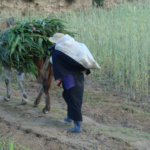


Ethiopian Institute of Agricultural Research
Kenya
12/2014—7/2016
In Ethiopia, the land holding size is shrinking every year with population increasing at an alarming rate. For instance, the population is growing at 2.89 per year and the land is shrinking due to the population growth and accompanied constructions. At the same time, soil fertility is declining, resulting in poor crop production due to soil erosion caused by soil cover removal from farmlands. The crop production is also fluctuating because of moisture stresses. Therefore, it becomes increasingly important to utilize land effectively and use improved crop varieties. Sorghum and legumes are essential crops for small-scale farmers in Ethiopia. Sorghum adapts better in moisture stress areas than most of the food crops grown in Ethiopia. Likewise, pulses such as common bean, pigeon pea, and mung bean are important food and cash crops. Pulses are also mildly drought tolerant or early maturing crops, which make them suitable for production under smallholder farmers. Sorghum and pulses are compatible for intercropping to reduce the risk of total crop failure and help to avoid dependency on one crop. The end goal of this project is to increase crop productivity and increase access to diversified food sources for smallholder farmers in Ethiopia. This project will involve a range of partners and stakeholders, who will participate in the research and development activities, including EIAR breeders, agronomists, agro-engineers, socio-economists and researchers from Oromia Agricultural Research, experts from the Ministry of Agriculture at various levels, farmer organizations (farmer cooperatives, grassroots administration, Farmer Research Groups and their networks), and local NGOs. This will use farmer research groups in order to enhance mutual learning, farmers’ capacity to conduct organized observation, share results, and continue tackling and solving new problems facing them.
Sorghum pulse intercropping improves resource use (land, labor), efficiency of farmers and enhances farm income.Grain yield increase of food crops under smallholder farmer conditions through increased grain biomass and cross monetary value through enhanced crop productivity due to soil fertility enhancement.
